NUR1201: Preventing Patient Falls and Harm from Falls
VerifiedAdded on 2023/06/07
|7
|1882
|396
Essay
AI Summary
This essay analyzes a case study involving Mr. William Taylor, a 75-year-old patient who experienced two falls. Using the Gibbs Reflective Cycle, the essay describes the situations, explores the feelings and thoughts of the student, examines values and beliefs, draws conclusions about the causes of the falls, and proposes an action plan for preventing future incidents. The analysis highlights the importance of considering both personal and systemic factors in patient falls, particularly in elderly patients. The essay also discusses the challenges of home-based care, including the need for increased monitoring, improved communication between patients and healthcare providers, and better patient education. The conclusion emphasizes the need for enhanced patient safety measures within healthcare settings, aiming to improve the patient experience and reduce the risk of falls and related injuries.
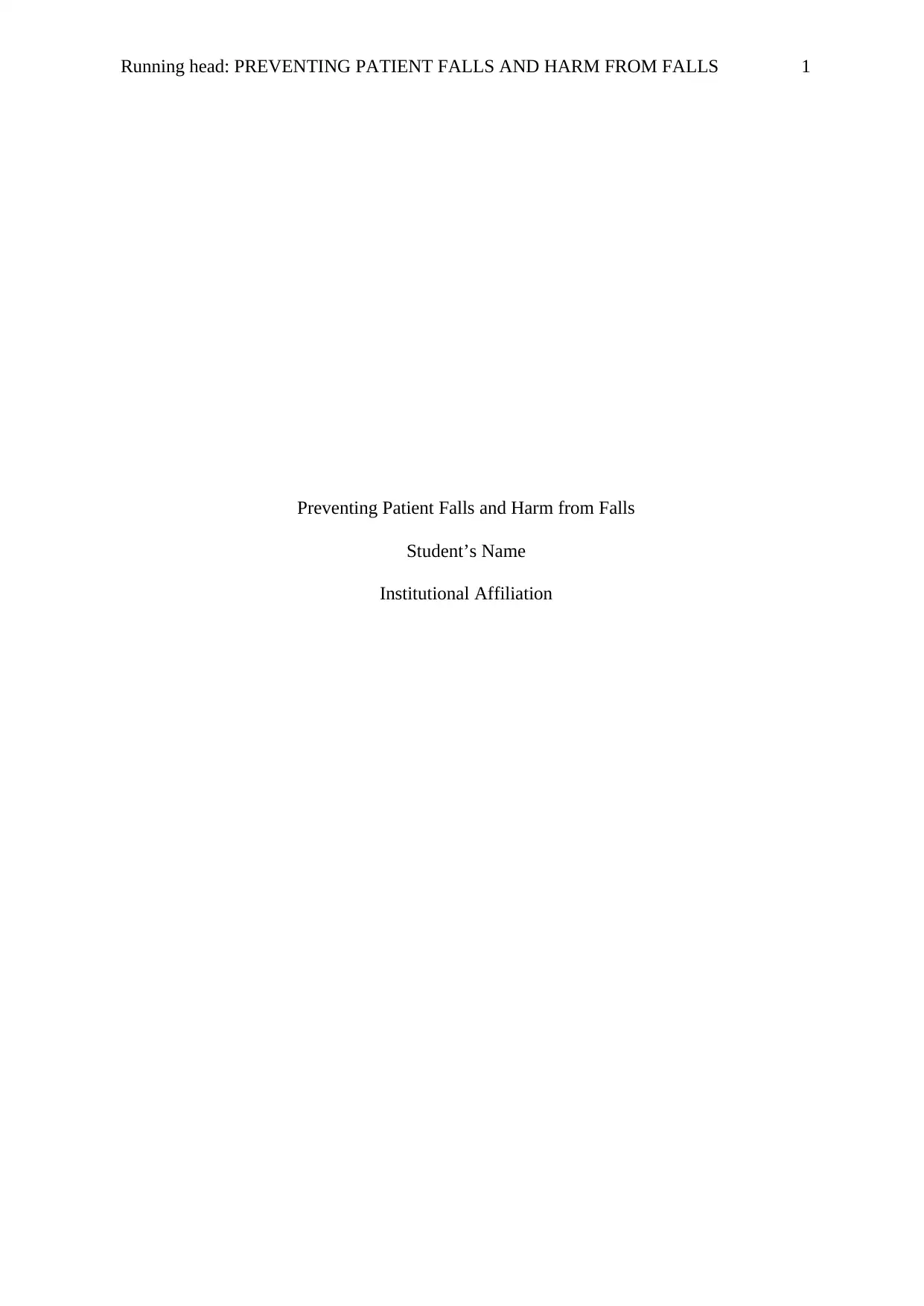
Running head: PREVENTING PATIENT FALLS AND HARM FROM FALLS 1
Preventing Patient Falls and Harm from Falls
Student’s Name
Institutional Affiliation
Preventing Patient Falls and Harm from Falls
Student’s Name
Institutional Affiliation
Paraphrase This Document
Need a fresh take? Get an instant paraphrase of this document with our AI Paraphraser
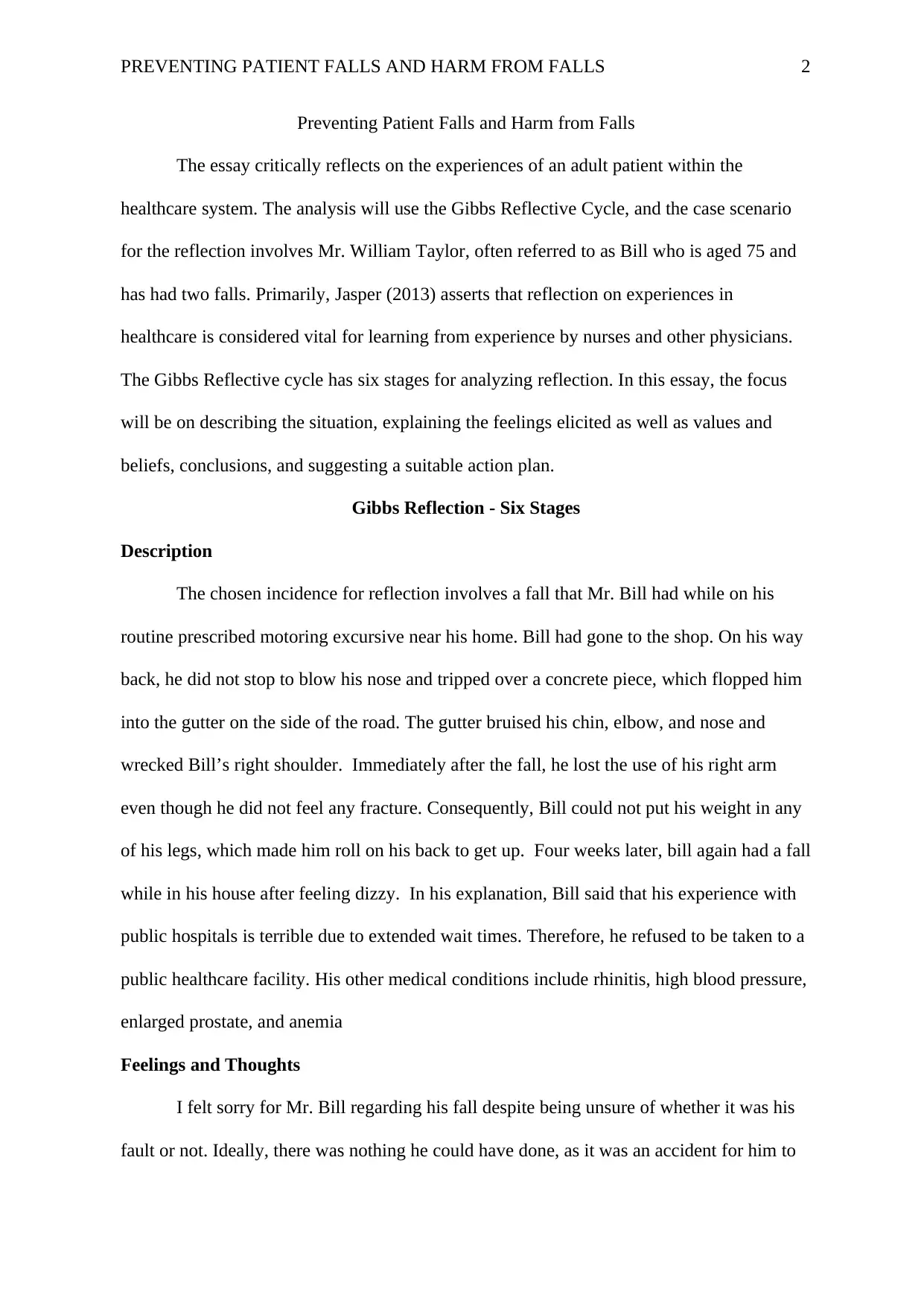
PREVENTING PATIENT FALLS AND HARM FROM FALLS 2
Preventing Patient Falls and Harm from Falls
The essay critically reflects on the experiences of an adult patient within the
healthcare system. The analysis will use the Gibbs Reflective Cycle, and the case scenario
for the reflection involves Mr. William Taylor, often referred to as Bill who is aged 75 and
has had two falls. Primarily, Jasper (2013) asserts that reflection on experiences in
healthcare is considered vital for learning from experience by nurses and other physicians.
The Gibbs Reflective cycle has six stages for analyzing reflection. In this essay, the focus
will be on describing the situation, explaining the feelings elicited as well as values and
beliefs, conclusions, and suggesting a suitable action plan.
Gibbs Reflection - Six Stages
Description
The chosen incidence for reflection involves a fall that Mr. Bill had while on his
routine prescribed motoring excursive near his home. Bill had gone to the shop. On his way
back, he did not stop to blow his nose and tripped over a concrete piece, which flopped him
into the gutter on the side of the road. The gutter bruised his chin, elbow, and nose and
wrecked Bill’s right shoulder. Immediately after the fall, he lost the use of his right arm
even though he did not feel any fracture. Consequently, Bill could not put his weight in any
of his legs, which made him roll on his back to get up. Four weeks later, bill again had a fall
while in his house after feeling dizzy. In his explanation, Bill said that his experience with
public hospitals is terrible due to extended wait times. Therefore, he refused to be taken to a
public healthcare facility. His other medical conditions include rhinitis, high blood pressure,
enlarged prostate, and anemia
Feelings and Thoughts
I felt sorry for Mr. Bill regarding his fall despite being unsure of whether it was his
fault or not. Ideally, there was nothing he could have done, as it was an accident for him to
Preventing Patient Falls and Harm from Falls
The essay critically reflects on the experiences of an adult patient within the
healthcare system. The analysis will use the Gibbs Reflective Cycle, and the case scenario
for the reflection involves Mr. William Taylor, often referred to as Bill who is aged 75 and
has had two falls. Primarily, Jasper (2013) asserts that reflection on experiences in
healthcare is considered vital for learning from experience by nurses and other physicians.
The Gibbs Reflective cycle has six stages for analyzing reflection. In this essay, the focus
will be on describing the situation, explaining the feelings elicited as well as values and
beliefs, conclusions, and suggesting a suitable action plan.
Gibbs Reflection - Six Stages
Description
The chosen incidence for reflection involves a fall that Mr. Bill had while on his
routine prescribed motoring excursive near his home. Bill had gone to the shop. On his way
back, he did not stop to blow his nose and tripped over a concrete piece, which flopped him
into the gutter on the side of the road. The gutter bruised his chin, elbow, and nose and
wrecked Bill’s right shoulder. Immediately after the fall, he lost the use of his right arm
even though he did not feel any fracture. Consequently, Bill could not put his weight in any
of his legs, which made him roll on his back to get up. Four weeks later, bill again had a fall
while in his house after feeling dizzy. In his explanation, Bill said that his experience with
public hospitals is terrible due to extended wait times. Therefore, he refused to be taken to a
public healthcare facility. His other medical conditions include rhinitis, high blood pressure,
enlarged prostate, and anemia
Feelings and Thoughts
I felt sorry for Mr. Bill regarding his fall despite being unsure of whether it was his
fault or not. Ideally, there was nothing he could have done, as it was an accident for him to
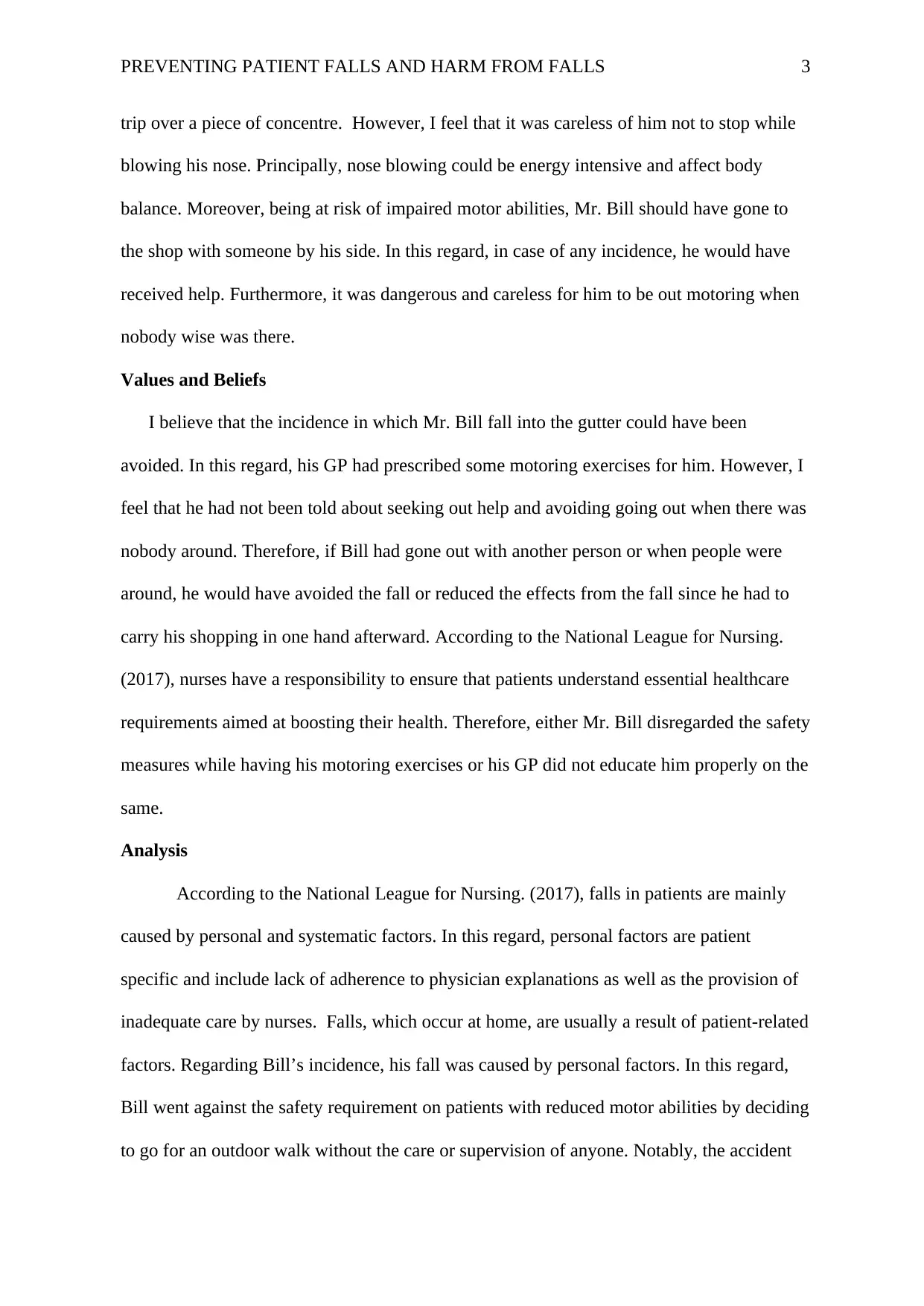
PREVENTING PATIENT FALLS AND HARM FROM FALLS 3
trip over a piece of concentre. However, I feel that it was careless of him not to stop while
blowing his nose. Principally, nose blowing could be energy intensive and affect body
balance. Moreover, being at risk of impaired motor abilities, Mr. Bill should have gone to
the shop with someone by his side. In this regard, in case of any incidence, he would have
received help. Furthermore, it was dangerous and careless for him to be out motoring when
nobody wise was there.
Values and Beliefs
I believe that the incidence in which Mr. Bill fall into the gutter could have been
avoided. In this regard, his GP had prescribed some motoring exercises for him. However, I
feel that he had not been told about seeking out help and avoiding going out when there was
nobody around. Therefore, if Bill had gone out with another person or when people were
around, he would have avoided the fall or reduced the effects from the fall since he had to
carry his shopping in one hand afterward. According to the National League for Nursing.
(2017), nurses have a responsibility to ensure that patients understand essential healthcare
requirements aimed at boosting their health. Therefore, either Mr. Bill disregarded the safety
measures while having his motoring exercises or his GP did not educate him properly on the
same.
Analysis
According to the National League for Nursing. (2017), falls in patients are mainly
caused by personal and systematic factors. In this regard, personal factors are patient
specific and include lack of adherence to physician explanations as well as the provision of
inadequate care by nurses. Falls, which occur at home, are usually a result of patient-related
factors. Regarding Bill’s incidence, his fall was caused by personal factors. In this regard,
Bill went against the safety requirement on patients with reduced motor abilities by deciding
to go for an outdoor walk without the care or supervision of anyone. Notably, the accident
trip over a piece of concentre. However, I feel that it was careless of him not to stop while
blowing his nose. Principally, nose blowing could be energy intensive and affect body
balance. Moreover, being at risk of impaired motor abilities, Mr. Bill should have gone to
the shop with someone by his side. In this regard, in case of any incidence, he would have
received help. Furthermore, it was dangerous and careless for him to be out motoring when
nobody wise was there.
Values and Beliefs
I believe that the incidence in which Mr. Bill fall into the gutter could have been
avoided. In this regard, his GP had prescribed some motoring exercises for him. However, I
feel that he had not been told about seeking out help and avoiding going out when there was
nobody around. Therefore, if Bill had gone out with another person or when people were
around, he would have avoided the fall or reduced the effects from the fall since he had to
carry his shopping in one hand afterward. According to the National League for Nursing.
(2017), nurses have a responsibility to ensure that patients understand essential healthcare
requirements aimed at boosting their health. Therefore, either Mr. Bill disregarded the safety
measures while having his motoring exercises or his GP did not educate him properly on the
same.
Analysis
According to the National League for Nursing. (2017), falls in patients are mainly
caused by personal and systematic factors. In this regard, personal factors are patient
specific and include lack of adherence to physician explanations as well as the provision of
inadequate care by nurses. Falls, which occur at home, are usually a result of patient-related
factors. Regarding Bill’s incidence, his fall was caused by personal factors. In this regard,
Bill went against the safety requirement on patients with reduced motor abilities by deciding
to go for an outdoor walk without the care or supervision of anyone. Notably, the accident
⊘ This is a preview!⊘
Do you want full access?
Subscribe today to unlock all pages.

Trusted by 1+ million students worldwide
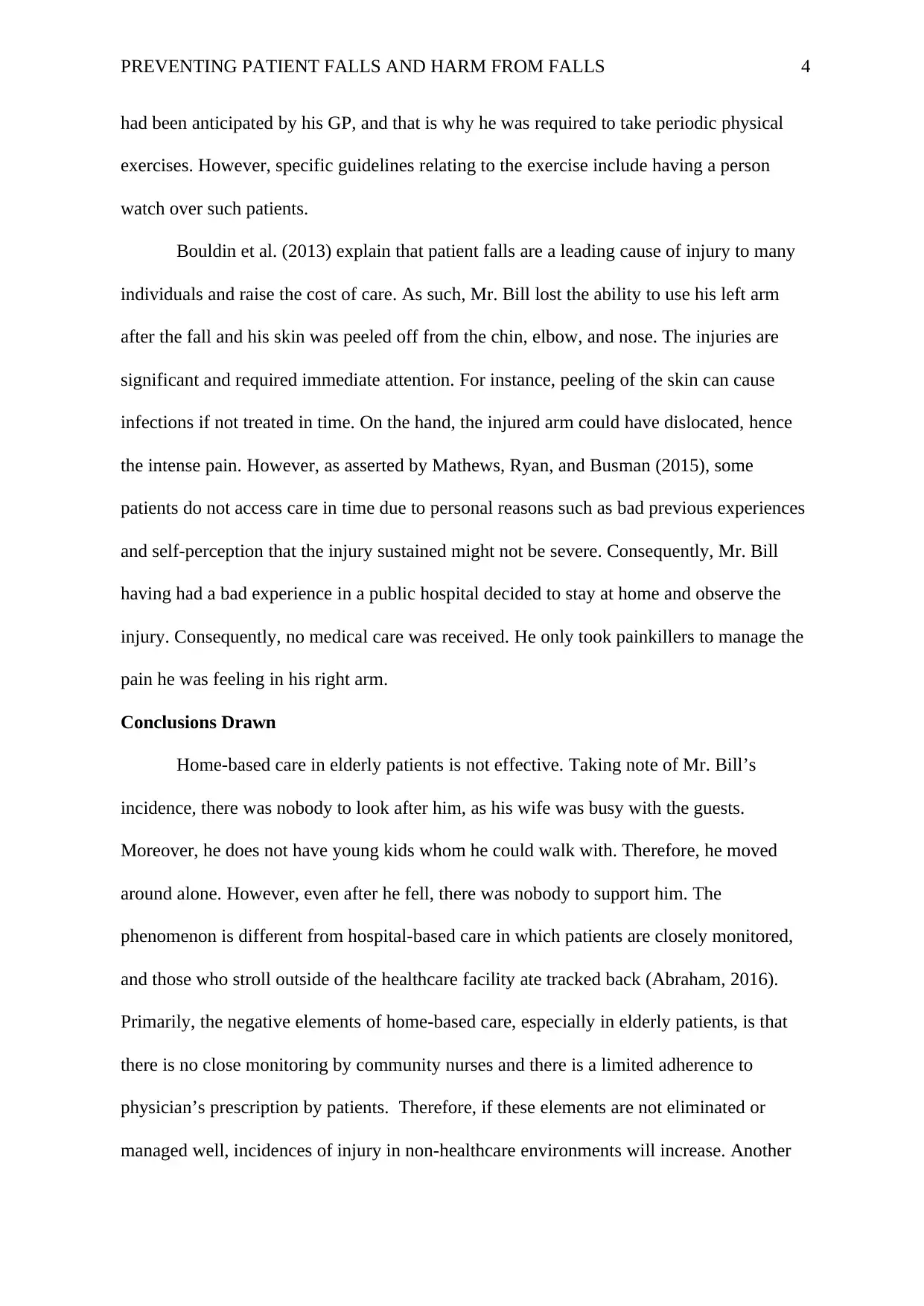
PREVENTING PATIENT FALLS AND HARM FROM FALLS 4
had been anticipated by his GP, and that is why he was required to take periodic physical
exercises. However, specific guidelines relating to the exercise include having a person
watch over such patients.
Bouldin et al. (2013) explain that patient falls are a leading cause of injury to many
individuals and raise the cost of care. As such, Mr. Bill lost the ability to use his left arm
after the fall and his skin was peeled off from the chin, elbow, and nose. The injuries are
significant and required immediate attention. For instance, peeling of the skin can cause
infections if not treated in time. On the hand, the injured arm could have dislocated, hence
the intense pain. However, as asserted by Mathews, Ryan, and Busman (2015), some
patients do not access care in time due to personal reasons such as bad previous experiences
and self-perception that the injury sustained might not be severe. Consequently, Mr. Bill
having had a bad experience in a public hospital decided to stay at home and observe the
injury. Consequently, no medical care was received. He only took painkillers to manage the
pain he was feeling in his right arm.
Conclusions Drawn
Home-based care in elderly patients is not effective. Taking note of Mr. Bill’s
incidence, there was nobody to look after him, as his wife was busy with the guests.
Moreover, he does not have young kids whom he could walk with. Therefore, he moved
around alone. However, even after he fell, there was nobody to support him. The
phenomenon is different from hospital-based care in which patients are closely monitored,
and those who stroll outside of the healthcare facility ate tracked back (Abraham, 2016).
Primarily, the negative elements of home-based care, especially in elderly patients, is that
there is no close monitoring by community nurses and there is a limited adherence to
physician’s prescription by patients. Therefore, if these elements are not eliminated or
managed well, incidences of injury in non-healthcare environments will increase. Another
had been anticipated by his GP, and that is why he was required to take periodic physical
exercises. However, specific guidelines relating to the exercise include having a person
watch over such patients.
Bouldin et al. (2013) explain that patient falls are a leading cause of injury to many
individuals and raise the cost of care. As such, Mr. Bill lost the ability to use his left arm
after the fall and his skin was peeled off from the chin, elbow, and nose. The injuries are
significant and required immediate attention. For instance, peeling of the skin can cause
infections if not treated in time. On the hand, the injured arm could have dislocated, hence
the intense pain. However, as asserted by Mathews, Ryan, and Busman (2015), some
patients do not access care in time due to personal reasons such as bad previous experiences
and self-perception that the injury sustained might not be severe. Consequently, Mr. Bill
having had a bad experience in a public hospital decided to stay at home and observe the
injury. Consequently, no medical care was received. He only took painkillers to manage the
pain he was feeling in his right arm.
Conclusions Drawn
Home-based care in elderly patients is not effective. Taking note of Mr. Bill’s
incidence, there was nobody to look after him, as his wife was busy with the guests.
Moreover, he does not have young kids whom he could walk with. Therefore, he moved
around alone. However, even after he fell, there was nobody to support him. The
phenomenon is different from hospital-based care in which patients are closely monitored,
and those who stroll outside of the healthcare facility ate tracked back (Abraham, 2016).
Primarily, the negative elements of home-based care, especially in elderly patients, is that
there is no close monitoring by community nurses and there is a limited adherence to
physician’s prescription by patients. Therefore, if these elements are not eliminated or
managed well, incidences of injury in non-healthcare environments will increase. Another
Paraphrase This Document
Need a fresh take? Get an instant paraphrase of this document with our AI Paraphraser

PREVENTING PATIENT FALLS AND HARM FROM FALLS 5
negative feature of home-based care is the lack of timely access to medical attention.
According to Reeve (2018), delayed access to care could lead to more complications thereby
increasing the cost of care and length of stay in hospital settings.
Patients understand primary medical practices and adhere to most directives by
nurses and other physicians. Regarding Bill, he had painkillers at home and understood that
they were vital in stopping his pain after he fell. Moreover, he remembered to take the
motoring exercises as prescribed by the GP. Principally, the two positive aspects can be
leveraged and extended to better home-based care. In this regard, patients can be taught on
how to manage long-term diseases such as diabetes or kidney dialysis from home, and with
periodic nurse check-ups, the aspect of home-based care can be improved. Currently, the
ability to remember the physician’s directives and manage some medicines will contribute
to enhanced trust in home-based care in the future.
Action Plan
Going forward, I will focus on increasing the level of elderly patient monitoring in-
home care as well as improving the level of awareness among community members
regarding the issue of falls. Primarily, I will have the number of community nurses
increased for them to be able to monitor patients who have been discharged while at home.
Moreover, I will take up the role of disseminating healthcare information among community
members on how to help those who are unwell. For instance, Mrs. Bill was busy with the
guests and therefore, disregarded the duty of taking his husband out for a walk. It is likely
that she would not have done so had she known how risky it was to Bill’s health. Lastly, it
will be essential to improve communication between patients and their doctors through other
approaches rather than eye to eye. In this regard, Bill could have informed his GP about the
fall and received professional advice instead of waiting for one more day.
Conclusion
negative feature of home-based care is the lack of timely access to medical attention.
According to Reeve (2018), delayed access to care could lead to more complications thereby
increasing the cost of care and length of stay in hospital settings.
Patients understand primary medical practices and adhere to most directives by
nurses and other physicians. Regarding Bill, he had painkillers at home and understood that
they were vital in stopping his pain after he fell. Moreover, he remembered to take the
motoring exercises as prescribed by the GP. Principally, the two positive aspects can be
leveraged and extended to better home-based care. In this regard, patients can be taught on
how to manage long-term diseases such as diabetes or kidney dialysis from home, and with
periodic nurse check-ups, the aspect of home-based care can be improved. Currently, the
ability to remember the physician’s directives and manage some medicines will contribute
to enhanced trust in home-based care in the future.
Action Plan
Going forward, I will focus on increasing the level of elderly patient monitoring in-
home care as well as improving the level of awareness among community members
regarding the issue of falls. Primarily, I will have the number of community nurses
increased for them to be able to monitor patients who have been discharged while at home.
Moreover, I will take up the role of disseminating healthcare information among community
members on how to help those who are unwell. For instance, Mrs. Bill was busy with the
guests and therefore, disregarded the duty of taking his husband out for a walk. It is likely
that she would not have done so had she known how risky it was to Bill’s health. Lastly, it
will be essential to improve communication between patients and their doctors through other
approaches rather than eye to eye. In this regard, Bill could have informed his GP about the
fall and received professional advice instead of waiting for one more day.
Conclusion

PREVENTING PATIENT FALLS AND HARM FROM FALLS 6
The Gibbs Reflective Cycle effectively analyses the case scenario involving Mr.
William Taylor. The analysis has enhanced my professional understanding of patient falls in
elderly patients regarding causes, effects, and reactions. Ideally, I now understand why
patients fall while on their own in home settings and why they hesitate to receive care.
Primarily, the falls result in injuries, which are sometimes costly. Therefore, in eliminating
these issues, enhanced monitoring of patients under the home-based care and proper
understanding of healthcare information by those around them and other community
members will be ideal. Moreover, it is vital for public healthcare facilities to enhance their
services to better patient experiences.
The Gibbs Reflective Cycle effectively analyses the case scenario involving Mr.
William Taylor. The analysis has enhanced my professional understanding of patient falls in
elderly patients regarding causes, effects, and reactions. Ideally, I now understand why
patients fall while on their own in home settings and why they hesitate to receive care.
Primarily, the falls result in injuries, which are sometimes costly. Therefore, in eliminating
these issues, enhanced monitoring of patients under the home-based care and proper
understanding of healthcare information by those around them and other community
members will be ideal. Moreover, it is vital for public healthcare facilities to enhance their
services to better patient experiences.
⊘ This is a preview!⊘
Do you want full access?
Subscribe today to unlock all pages.

Trusted by 1+ million students worldwide
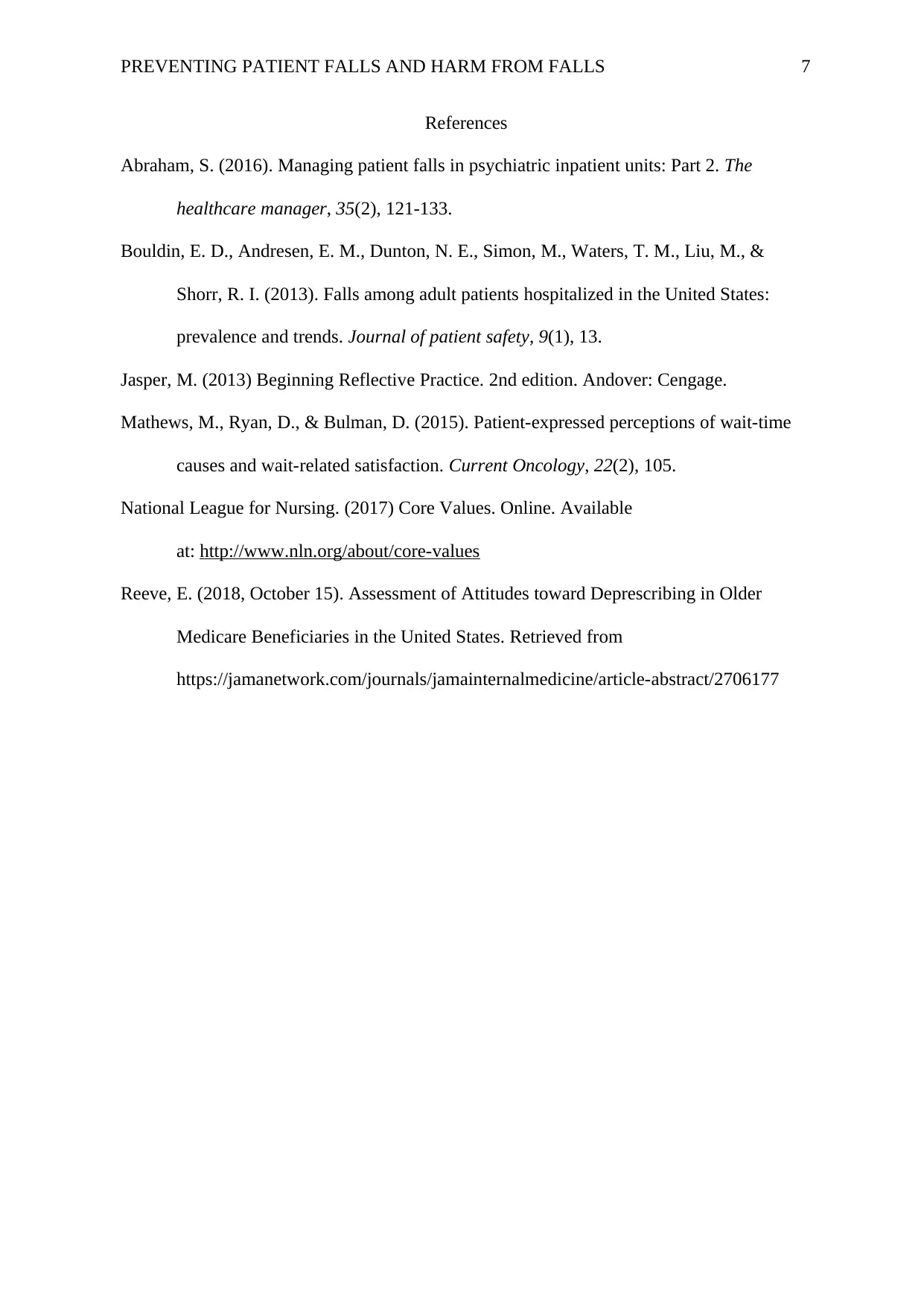
PREVENTING PATIENT FALLS AND HARM FROM FALLS 7
References
Abraham, S. (2016). Managing patient falls in psychiatric inpatient units: Part 2. The
healthcare manager, 35(2), 121-133.
Bouldin, E. D., Andresen, E. M., Dunton, N. E., Simon, M., Waters, T. M., Liu, M., &
Shorr, R. I. (2013). Falls among adult patients hospitalized in the United States:
prevalence and trends. Journal of patient safety, 9(1), 13.
Jasper, M. (2013) Beginning Reflective Practice. 2nd edition. Andover: Cengage.
Mathews, M., Ryan, D., & Bulman, D. (2015). Patient-expressed perceptions of wait-time
causes and wait-related satisfaction. Current Oncology, 22(2), 105.
National League for Nursing. (2017) Core Values. Online. Available
at: http://www.nln.org/about/core-values
Reeve, E. (2018, October 15). Assessment of Attitudes toward Deprescribing in Older
Medicare Beneficiaries in the United States. Retrieved from
https://jamanetwork.com/journals/jamainternalmedicine/article-abstract/2706177
References
Abraham, S. (2016). Managing patient falls in psychiatric inpatient units: Part 2. The
healthcare manager, 35(2), 121-133.
Bouldin, E. D., Andresen, E. M., Dunton, N. E., Simon, M., Waters, T. M., Liu, M., &
Shorr, R. I. (2013). Falls among adult patients hospitalized in the United States:
prevalence and trends. Journal of patient safety, 9(1), 13.
Jasper, M. (2013) Beginning Reflective Practice. 2nd edition. Andover: Cengage.
Mathews, M., Ryan, D., & Bulman, D. (2015). Patient-expressed perceptions of wait-time
causes and wait-related satisfaction. Current Oncology, 22(2), 105.
National League for Nursing. (2017) Core Values. Online. Available
at: http://www.nln.org/about/core-values
Reeve, E. (2018, October 15). Assessment of Attitudes toward Deprescribing in Older
Medicare Beneficiaries in the United States. Retrieved from
https://jamanetwork.com/journals/jamainternalmedicine/article-abstract/2706177
1 out of 7
Related Documents
Your All-in-One AI-Powered Toolkit for Academic Success.
+13062052269
info@desklib.com
Available 24*7 on WhatsApp / Email
![[object Object]](/_next/static/media/star-bottom.7253800d.svg)
Unlock your academic potential
Copyright © 2020–2025 A2Z Services. All Rights Reserved. Developed and managed by ZUCOL.





